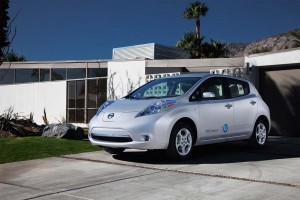Unexpectedly strong demand for the Nissan Leaf and Tesla Model S suggest that the battery-car market might finally be sparking interest with American buyers.
Both the Japanese maker and its new California-based rival have experienced a surge in sales in recent weeks and expect that pace to continue – albeit by nurturing demand with new efforts to reduce the cost of ownership.
Other makers, including Ford and Honda, also appear to be gaining traction in a market that has until now been skeptical to embrace the claimed advantages of electrification. Even at Chevrolet, where sales of the Volt plug-in hybrid took an unexpected tumble in March, company officials said they’re still pleased with the general trend in sales since the beginning of the year.
Nissan officials seemed particularly pleased with the results for Leaf. Launched in late 2011, sales of the battery-electric vehicle dragged well below expectations last year, leading some skeptics to anticipate the Japanese maker might have to back off on its optimistic plans – which call for the launch of a second model for the Infiniti brand sometime in 2014.
Nissan did, indeed, respond, but by adding a new, lower-trim Leaf out of its new plant in Smyrna, Tennessee. By reducing the base price to $28,800 – not including state and federal tax credits that can cut that figure by another $10,000 – the Leaf has suddenly caught fire. In fact, the 2,236 sold in March sharply exceeded the forecast made by Nissan Motor Co. CEO Carlos Ghosn during last week’s New York Auto Show where he forecast deliveries of about 1,900.
Sales for the quarter were just 3,539, suggesting things could get a lot better in the months ahead if March wasn’t an anomaly for the Nissan Leaf. The same could be the case for the Tesla Model S, which is suddenly plugging into the market after a painfully slow launch in 2012.
While the maker has yet to release specific numbers for March, CEO Elon Musk confirmed this week that demand for the Tesla Model S rose to “more than 4,750” during the January – March quarter, and suggested the start-up is targeting sales in excess of 6,000 to 7,000 in the quarters to come.
Perhaps more significant was Musk’s claim that Tesla turned its first profit in the recently closed quarter.
As with Nissan, Musk has seen that cost is a key to maintaining momentum, especially for a battery car that carries a sticker of as much as $100,000 when fully loaded. “I’d like to broaden the affordability of our products,” Musk declared during a Tuesday afternoon conference call with reporters.
During that session, he announced a new finance program intended to offer the best of both leasing and outright purchasing. Buyers will be able to return their Model S sedans after three years and receive a residual matching the trade-in value of a Mercedes-Benz S-Class. And to further enhance the appeal considering Tesla’s lack of a track record, the entrepreneur promised to back the program with his “personal assets” no matter what happens to his new car company.
If there was any disappointment in March in the nascent battery-car market it came at Chevrolet where sales of the plug-in Volt slumped by more than a third, to 1,478, compared to year-earlier levels. For the first quarter, Volt is still up 8.4%, to 4,244. That means it remains ahead of the Nissan Leaf which generated a three-month tally of 3,539, and the 2,353 sales for the Toyota Prius plug-in – though Volt is now second in the market to the Tesla Model S.
So far, several other battery makers have yet to release figures for March and the year-to-date, but things aren’t expected to look good for the other big California start-up Fisker Automotive, which saw its founder Henrik Fisker resign last month. And on Monday, U.S. employees returned to the job after a cost-saving, week-long furlough.
Though Ford Motor Co. hasn’t yet released its sales data, an official not authorized to go on the record told TheDetroitBureau.com the maker expects its “best first-quarter results ever” when it comes to hybrids, plug-ins and pure BEVs. Expect something on the order of 7,500 battery-based vehicles and just under 1,000 of the more advanced models like the C-Max Energi plug-in and Ford Focus Electric.
Of course, Ford is just ramping up production – and has also taken steps such as discounting the Focus battery-car – so the numbers likely will be difficult to use to judge longer-term trends.
We’ll also have to wait for numbers from Mitsubishi, which has seen little demand for the tiny i-MiEV. And Honda is also too new a player to form much of a sense of its trendline. But it did see a big jump from a percentage base, selling 26 of the all-new Accord Plug-In Hybrid in March, compared to 19 in January and February combined. The 23 Fit EVs sold in March also matched demand during the first two months.
Add them all up, and advanced battery models are still barely showing up on the sales charts as more than an asterisk, but considering last year’s poor performance, anything pointing north is a much-needed trend in the right direction for battery-car advocates.


Hopefully GM will soon find a way to reduce the price of the Volt.